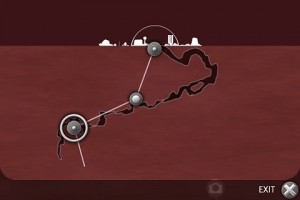 How much research did the Tiger Style team do on the Red Planet while prepping for this project? Are there any really obscure factoids about Mars you discovered that the rest of us might not know about, or that we’d find totally mind-blowing? And considering that we’ve got rovers still running around on the planet currently, did brand new real-world discoveries factor into the game’s design at all after the project got rolling?
How much research did the Tiger Style team do on the Red Planet while prepping for this project? Are there any really obscure factoids about Mars you discovered that the rest of us might not know about, or that we’d find totally mind-blowing? And considering that we’ve got rovers still running around on the planet currently, did brand new real-world discoveries factor into the game’s design at all after the project got rolling?
Randy: I did tons of research for this project, on a wide variety of topics, because I wanted Waking Mars to be legitimate science fiction, based on factual information, with a tone of credibility and plausibility. One of the first and most important questions was: could there be life on Mars, and if so, could it exist in caves? Right away I was excited to find out that caves have recently been observed on Mars: a type of cave called lava tubes, which also exist here on Earth and which form when lava flowing over the surface cools and solidifies. The first few cave chambers in Waking Mars are lava tubes, based on the Earth reference, until you get to some more interesting cave types even deeper underground. Those also have some meaning: there are only certain conditions under which they could have formed, so their existence tells you something about the deep past of the planet, again, just like caves on Earth.
 As for the question of whether life could exist on Mars: that turned out to be one of the more active and important questions in space science and exploration today. Scientists, of course, are very skeptical by training and careful not to make claims that could turn out to be false, so it took a lot of research to tease out the specific answer I was looking for from all the data that’s been collected about Mars. What I learned was that there is plenty of evidence that at various times huge amounts of water have flowed over the surface. Today conditions aren’t right for liquid water to exist on Mars; it’s incredibly cold and the atmospheric pressure is too low, so any liquid water would instantly freeze or sublimate away. But satellites can see dried-up riverbeds and outflow channels from torrential floods. There’s growing evidence that the entire northern hemisphere was once covered by a gigantic ocean. So what happened to all the water? It’s an important question, because for all of the life forms that we know about today, no matter how bizarre and no matter in which extreme climate they thrive, they require liquid water as a sort of organic lubricant for the crucial chemical interactions that allow life to exist: metabolism, respiration, reproduction, growth, and so forth. Without water, there can’t be life as we know it.
As for the question of whether life could exist on Mars: that turned out to be one of the more active and important questions in space science and exploration today. Scientists, of course, are very skeptical by training and careful not to make claims that could turn out to be false, so it took a lot of research to tease out the specific answer I was looking for from all the data that’s been collected about Mars. What I learned was that there is plenty of evidence that at various times huge amounts of water have flowed over the surface. Today conditions aren’t right for liquid water to exist on Mars; it’s incredibly cold and the atmospheric pressure is too low, so any liquid water would instantly freeze or sublimate away. But satellites can see dried-up riverbeds and outflow channels from torrential floods. There’s growing evidence that the entire northern hemisphere was once covered by a gigantic ocean. So what happened to all the water? It’s an important question, because for all of the life forms that we know about today, no matter how bizarre and no matter in which extreme climate they thrive, they require liquid water as a sort of organic lubricant for the crucial chemical interactions that allow life to exist: metabolism, respiration, reproduction, growth, and so forth. Without water, there can’t be life as we know it.
No one knows for sure what happened to the water, but the most plausible speculation starts with the once-molten core of Mars. It’s similar to Earth’s, with one important difference: Earth’s core still swirls around, and the convection of that molten metal produces Earth’s electromagnetic field, the thing that makes compass needles point north. The electromagnetic field does something else, too: it deflects intense waves of radiation from the Sun called the solar wind, which constantly bombards all the planets. There is evidence that Mars once had an electromagnetic field like Earth’s, but since the core cooled off and solidified, the field went away, which meant the planet was no longer shielded from the solar wind. The solar wind then ripped away the atmosphere that ancient Mars once had. Since the atmosphere is like a blanket that traps heat and pressure, the surface could no longer support liquid water.
 So, what happened to the oceans of ancient Mars when the planet could no longer support them? One possibility is that they evaporated into space, but another is that they were subsumed underground. From time to time over the past several billion years, some of that water might have broken free from enormous underground reservoirs and flowed torrentially over the surface, leaving behind the marks we see today. In fact, deep underground in the caves that really do exist on Mars, if any molten magma still flows and heats its surroundings, conditions could be right for that water to be in liquid form and for there to be enough energy and sustenance to support an ecosystem.
So, what happened to the oceans of ancient Mars when the planet could no longer support them? One possibility is that they evaporated into space, but another is that they were subsumed underground. From time to time over the past several billion years, some of that water might have broken free from enormous underground reservoirs and flowed torrentially over the surface, leaving behind the marks we see today. In fact, deep underground in the caves that really do exist on Mars, if any molten magma still flows and heats its surroundings, conditions could be right for that water to be in liquid form and for there to be enough energy and sustenance to support an ecosystem.
As you play Waking Mars, you’ll see places where this research was applied in terms of how we are depicting an environment that could support life. And, in fact, if conditions on Mars ever were a match for this speculation, that suggests there was a long period of time when Mars was habitable, not unlike how Earth is today. Everything we know about evolution suggests that life may well have evolved on Mars during that time, because when conditions are right, life probably emerges quickly. And that is amazing to think about: an ancient planet, billions of years ago at the birth of our solar system, that was already full of life forms when Earth was still in its primordial stages. It would have had rain, rivers, clouds, and life. What would it have been like to walk on Mars back then? What would those creatures and ecosystems have been like, and what would have happened to them when their planet started to become more and more barren and uninhabitable? That’s the story of our game, but it’s also entirely possible that it could have been true, long before humans ever existed.


